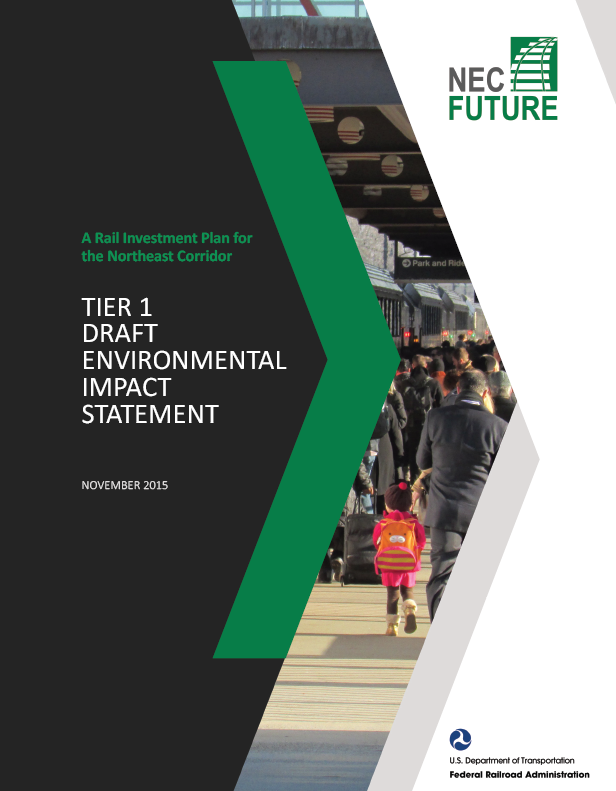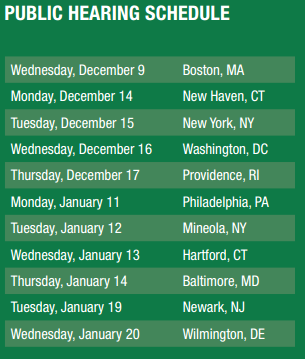Shaping Rail’s Future in the Northeast
The Northeast Corridor (NEC) passenger rail line is a central transportation spine for the region, stretching 457 miles from Washington, D.C., to Boston. It is one of the most heavily traveled rail corridors in the world, moving 750,000 passengers every day on 2,200 trains.
The NEC supports a regional economy that produces $3 trillion in yearly economic output—more than the gross domestic product of France. But the NEC also operates on outdated infrastructure with capacity constraints. By 2040, the Northeast is expected to add 7 million new residents, putting further pressure on the transportation system.
The Federal Railroad Administration (FRA) initiated NEC FUTURE to develop a long-term vision and near-term action to improve passenger rail service. NEC FUTURE is a comprehensive planning effort to define, evaluate, and prioritize future rail investments.
 FRA recently released the NEC FUTURE Tier 1 Draft Environmental Impact Statement (EIS), which examines the broad impacts of three “Action Alternatives” (against a “No Action Alternative”) to improve passenger rail service for the NEC. The Tier 1 Draft EIS considers impacts to transportation, the economy, the environment, and natural resources.
FRA recently released the NEC FUTURE Tier 1 Draft Environmental Impact Statement (EIS), which examines the broad impacts of three “Action Alternatives” (against a “No Action Alternative”) to improve passenger rail service for the NEC. The Tier 1 Draft EIS considers impacts to transportation, the economy, the environment, and natural resources.
FRA worked closely with the Federal Transit Administration—a cooperating agency on the Tier 1 Draft EIS—the NEC Infrastructure and Operations Advisory Commission, railroad operators, state and federal agencies, and the public.
About a dozen Volpe staff members across multiple divisions now support FRA’s oversight and developed the NEC FUTURE program, providing technical guidance and environmental support.
“We support FRA through management of technical work, including environmental support and ridership model development,” said Becky Blatnica, an environmental protection specialist at Volpe who serves as FRA’s Deputy Program Manager for NEC FUTURE. “We also support FRA with public and stakeholder engagement, a crucial component for this process.”
Three Visions for Rail in the Northeast
FRA developed three distinct Action Alternatives for evaluation in the Tier 1 Draft EIS, each of which presents a different vision for the future role of passenger rail in the transportation system of the Northeast.
These Action Alternatives are compared in the Tier 1 Draft EIS to a baseline: the No Action Alternative. The No Action Alternative includes projects currently planned and programmed, and repairs to keep the railroad running, but cannot accommodate the full volume of passengers who will want to travel by rail in 2040.
Alternative 1 maintains the role of rail as it is today, with sufficient service levels to keep pace with the significant growth projects in the region’s population, employment, and travel demand, but with little additional capacity to support growth after 2040. This alternative includes an increase in intercity and regional rail service.
Alternative 2 expands the role of rail to accommodate a greater portion of Northeast travelers as population and employment grow, and modest capacity to support growth beyond 2040. Alternative 2 provides five times as much intercity service and more than double peak-hour regional rail service compared to the No Action Alternative.
Alternative 3 transforms the role of rail, with rail becoming the dominant travel mode in the Northeast. Along with improvements to the existing NEC, a second spine from Washington, D.C., to Boston supports faster trips and serves markets that are not well connected by passenger rail. This alternative provides six times as much intercity service and more than triple peak-hour regional rail service compared to the No Action Alternative.
All of the Action Alternatives would bring the existing NEC to a state of good repair, incorporate innovative approaches for increased efficiencies, address pressing chokepoints, and protect freight rail access.
Public Feedback: FRA Wants to Hear Your Voice

“FRA is looking for feedback on what the role of rail should be in our transportation system. This overall vision will provide the envelope over the next few decades for future investments and prioritize decisions in the Northeast,” said Becky Blatnica, an environmental protection specialist at Volpe who serves as FRA’s Deputy Program Manager for NEC FUTURE.
“Rail investments last a really long time,” Blatnica said. “Some of the assets along the Northeast Corridor are over 100 years old today, so there is significant need for improvement now and smart choices for the future. Feedback from the public on investment levels, and types of passenger services—all of that is important for the FRA’s decision-making process.”
Provide your input on the Tier 1 Draft EIS by submitting your feedback online, emailing comment@necfuture.com, or attending a public hearing.
You may also mail comments to:
NEC FUTURE
U.S. DOT Federal Railroad Administration
One Bowling Green, Suite 429
New York, NY 10004
